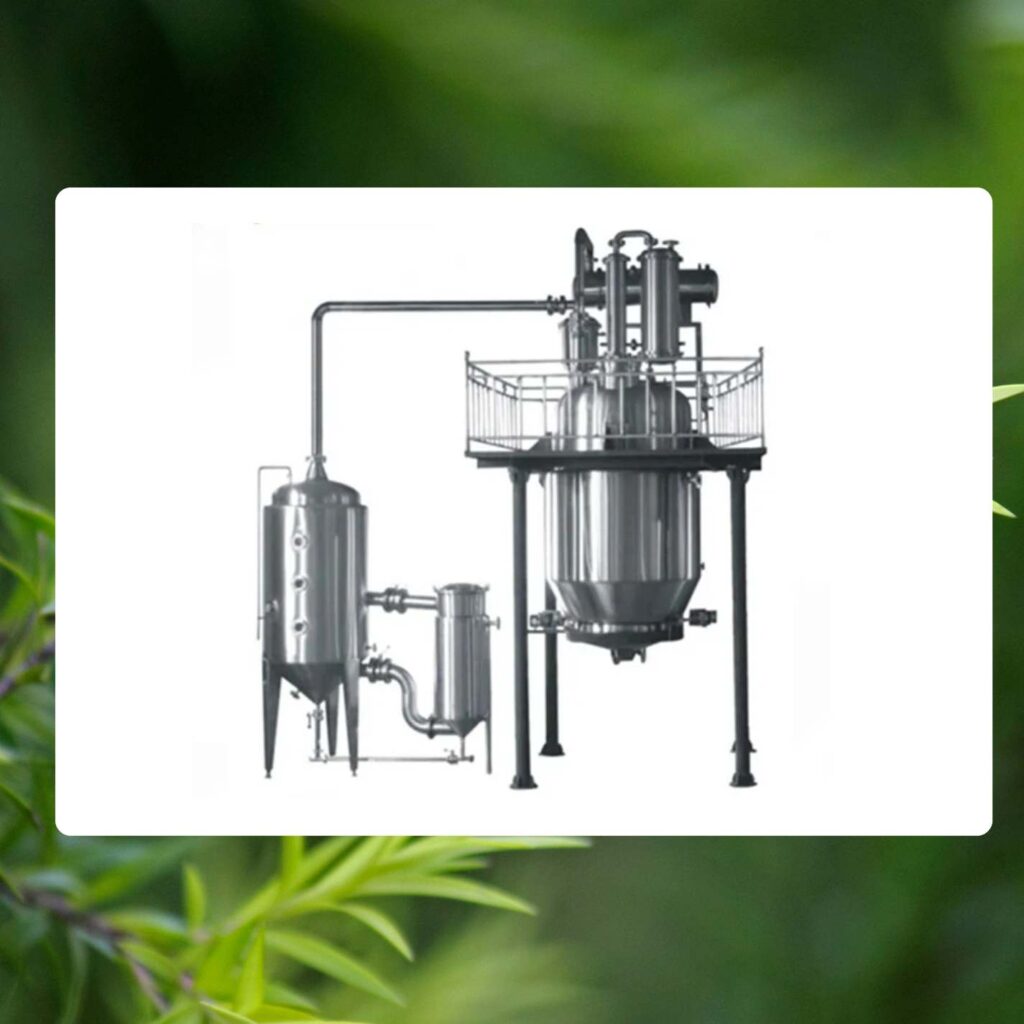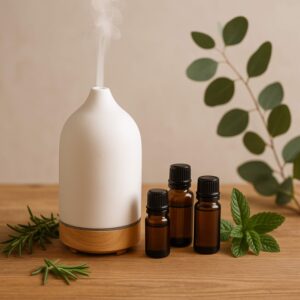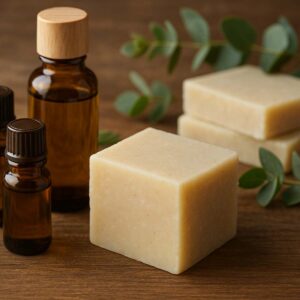How CO₂ Supercritical Extraction Works in Essential Oil Production
Introduction: The Modern Revolution in Essential Oil Extraction
While steam distillation and cold pressing have been used for centuries, the essential oil industry has embraced a modern, high-tech method: CO₂ Supercritical Extraction.
This process uses carbon dioxide (CO₂) under controlled temperature and pressure to extract oils. Unlike heat-based or solvent-based methods, CO₂ extraction is clean, precise, and residue-free, producing oils closer to the plant’s true aromatic profile.
Today, CO₂ extraction is used not only for essential oils but also for oleoresins, herbal extracts, nutraceuticals, and even coffee decaffeination. It has become especially popular for premium oils where purity and delicate compound preservation are critical.
What Is CO₂ Supercritical Extraction?
- At normal conditions, CO₂ is a gas.
- Under high pressure and moderate temperature, it enters a supercritical state — having properties of both liquid and gas.
- In this state, CO₂ acts as a solvent, penetrating plant material like a gas but dissolving compounds like a liquid.
- Once pressure is released, CO₂ returns to gas form, leaving pure essential oil extract without residues.
👉 This makes CO₂ extraction one of the cleanest and most efficient extraction methods available.
The Science Behind CO₂ Extraction
- Supercritical Point: Achieved at ~31°C and 74 bar (1071 psi).
- Solvent Power: CO₂ in this state dissolves essential oils, oleoresins, and bioactives.
- Selectivity: By adjusting pressure and temperature, different compounds can be selectively extracted (e.g., terpenes vs. heavier resins).
- Residue Free: Once extraction is complete, CO₂ evaporates, leaving a pure product.
Step-by-Step Process of CO₂ Extraction
Step 1: Loading the Plant Material
- Dried or fresh material is placed in a steel extraction vessel.
- Common plants: chamomile, frankincense, sandalwood, ginger, turmeric, vanilla.
Step 2: Pressurizing with CO₂
- CO₂ is pumped into the vessel under high pressure and controlled temperature.
- It becomes supercritical and penetrates the plant matrix.
Step 3: Solubilization
- The CO₂ dissolves volatile oils, resins, and other bioactives.
Step 4: Separation
- The mixture flows into a separator chamber where pressure is lowered.
- CO₂ turns back into gas and evaporates.
- Left behind: pure essential oil or oleoresin extract.
Step 5: Collection & Filtration
- Extract is collected, sometimes fractionated into light (aromatic terpenes) and heavy (resins, waxes) fractions.
Essential Oils & Extracts Commonly Produced by CO₂ Extraction
Chamomile Oil 🌼 – richer in azulene than steam-distilled version.
Frankincense 🌿 – deeper resinous profile.
Sandalwood 🌳 – premium perfumery oil.
Vanilla Oleoresin 🍦 – solvent-free vanilla extract.
Pepper, Ginger & Turmeric 🌿 – rich in gingerols/curcuminoids for nutraceuticals.
Cannabis/Hemp Extracts 🌱 – cannabinoids and terpenes preserved.
Advantages of CO₂ Supercritical Extraction
- Solvent-free & residue-free – no chemical traces.
- Low-temperature process – preserves delicate compounds.
- Selective control – tunable for light aromatics or heavier resins.
- High purity – extracts full-spectrum oils with both volatile and non-volatile compounds.
- Eco-friendly – CO₂ is non-toxic, recyclable, and widely available.
Limitations and Challenges
- High cost: Requires expensive equipment and high pressure.
- Technical expertise: Requires trained operators and precision controls.
- Not always necessary: For bulk oils like lemon or peppermint, steam distillation is more cost-effective.
- Viscous extracts: Some CO₂ oils are thick and need dilution before use.
Applications Across Industries
1. Aromatherapy & Wellness
CO₂-extracted oils are highly valued in the aromatherapy and holistic wellness industry because they preserve a fuller spectrum of plant compounds compared to steam distillation. For example:
- Chamomile CO₂ retains higher azulene levels, giving it a richer calming and anti-inflammatory profile, making it ideal for relaxation blends and stress-relief products.
- Frankincense CO₂ offers a deeper resinous character, widely used in meditation oils, incense blends, and spiritual products.
- Sandalwood CO₂ provides a smoother, longer-lasting aroma, making it highly sought after for grounding and mindfulness practices.
These oils appeal to wellness brands looking for premium-grade extracts that deliver both therapeutic benefits and complex aroma profiles.
2. Cosmetics & Beauty
The cosmetic and skincare industry increasingly favors CO₂ extracts because they are solvent-free, residue-free, and gentle on skin formulations.
- In luxury perfumes, CO₂ extracts like rose, jasmine, and sandalwood provide true-to-nature fragrances that are more stable and longer-lasting than distilled oils.
- In creams and serums, extracts like calendula CO₂ or chamomile CO₂ are prized for their skin-soothing and anti-inflammatory properties.
- Anti-aging formulations often incorporate frankincense CO₂ for its skin rejuvenation potential.
Brands use CO₂ extracts to highlight clean-label, high-performance, and natural beauty claims — which resonate strongly with today’s consumers.
3. Pharmaceuticals & Nutraceuticals
CO₂ extraction allows standardized, high-purity extracts that meet strict pharmaceutical and nutraceutical requirements.
- Turmeric CO₂ is concentrated in curcuminoids, making it ideal for anti-inflammatory capsules, joint health supplements, and digestive formulas.
- Ginger CO₂ is rich in gingerols and shogaols, commonly used in anti-nausea remedies, digestive aids, and arthritis formulations.
- Peppermint CO₂ is standardized for menthol content, used in capsules, topical gels, and cough remedies.
Because CO₂ extracts are residue-free and reproducible, they are widely adopted in clinical-grade nutraceuticals and over-the-counter (OTC) products.
4. Food & Beverages
CO₂ extraction is a game-changer for natural food and beverage flavoring, as it produces clean-label extracts without chemical residues.
- Vanilla CO₂ extracts are preferred for high-end ice creams, baked goods, and beverages where solvent residues would not be acceptable.
- Spice extracts such as black pepper, cardamom, cinnamon, and clove CO₂ are widely used in seasonings, sauces, meat marinades, and snack coatings.
- Citrus CO₂ oils (orange, lemon, lime) add fresh flavor to soft drinks, candies, and flavored teas.
Food manufacturers increasingly choose CO₂ extracts for label transparency and regulatory compliance in natural flavorings.
5. Household & Cleaning Products
CO₂ supercritical extraction also provides advantages in the household and natural cleaning industry, where demand for eco-friendly, chemical-free ingredients is rapidly growing.
- Citrus CO₂ oils (lemon, orange, lime, grapefruit) are widely used in all-purpose cleaners, degreasers, dish soaps, and air fresheners. Compared to steam-distilled versions, they retain a fresher, truer-to-fruit aroma.
- Herbal CO₂ extracts such as thyme, oregano, and clove provide natural antibacterial and antifungal properties, making them valuable in surface sprays and eco-detergents.
- Pine CO₂ extract adds a clean, refreshing scent while contributing mild disinfectant qualities.
Because CO₂ extraction leaves no solvent residues, these oils are ideal for brands emphasizing non-toxic, safe-for-home, and green cleaning products.
How Buyers Can Judge Quality of CO₂ Extracts
- GC/MS Testing – confirms purity and chemical profile.
- COA (Certificate of Analysis) – shows content of actives like curcumin or azulene.
- Appearance & Consistency – CO₂ extracts are often thicker than distilled oils.
- Certifications – Organic, GMP, ISO ensure credibility.
- Supplier Transparency – origin, batch traceability, extraction specs.
Modern Innovations in CO₂ Extraction
- Subcritical CO₂ extraction (lower pressure, milder extracts).
- Fractional CO₂ extraction (separates terpenes from heavy resins).
- Green technology improvements – energy recovery and recycling systems.
- Micro-extraction systems – for small-batch artisan oils.
FAQs About CO₂ Supercritical Extraction
Q1: Is CO₂ extraction better than steam distillation?
👉 For delicate flowers and resins, yes — it captures compounds that steam might destroy. For everyday bulk oils, steam is more cost-efficient.
Q2: Are CO₂ oils stronger than regular essential oils?
👉 They often have a fuller, richer profile, containing both volatile oils and heavier plant compounds.
Q3: Is CO₂ extraction safe?
👉 Yes — CO₂ is non-toxic, food-grade, and leaves no residue.
Conclusion: Why CO₂ Extraction Represents the Future
CO₂ Supercritical Extraction has transformed the essential oil industry, offering high-purity, solvent-free, full-spectrum extracts that appeal to both consumers and manufacturers. While it’s more costly than steam distillation or cold pressing, the premium quality and delicate preservation make it invaluable in aromatherapy, cosmetics, pharmaceuticals, and food industries.
👉 At EssentialOilOnline.com, we offer CO₂-extracted oils and oleoresins including chamomile, frankincense, sandalwood, ginger, turmeric, and vanilla. Contact us today to request a wholesale quote and bring the cleanest, most potent extracts to your brand.




